Aligning your content with the stages of the marketing funnel is important because it means that your content resonates with your audience as they progress through their content journey.
In this article, we have listed 24 content formats designed to connect with your audience at different stages of their buying journey.
We will provide examples and guidance for creating the right marketing content that targets potential customers at every stage of the sales funnel.
These 24 content formats include:
- Educational blog posts
- Infographics
- Checklist
- Podcast
- Ebooks
Keep reading to learn more about developing a content strategy for each marketing funnel stage and how it can help your brand gain attention and conversions.
Table of Contents
What is a Content Marketing Funnel?
The marketing funnel is a key concept in digital marketing, outlining the customer journey from the initial point of awareness to the ultimate goal of conversion.
It includes distinct stages, each with a specific role in guiding leads toward becoming loyal customers.
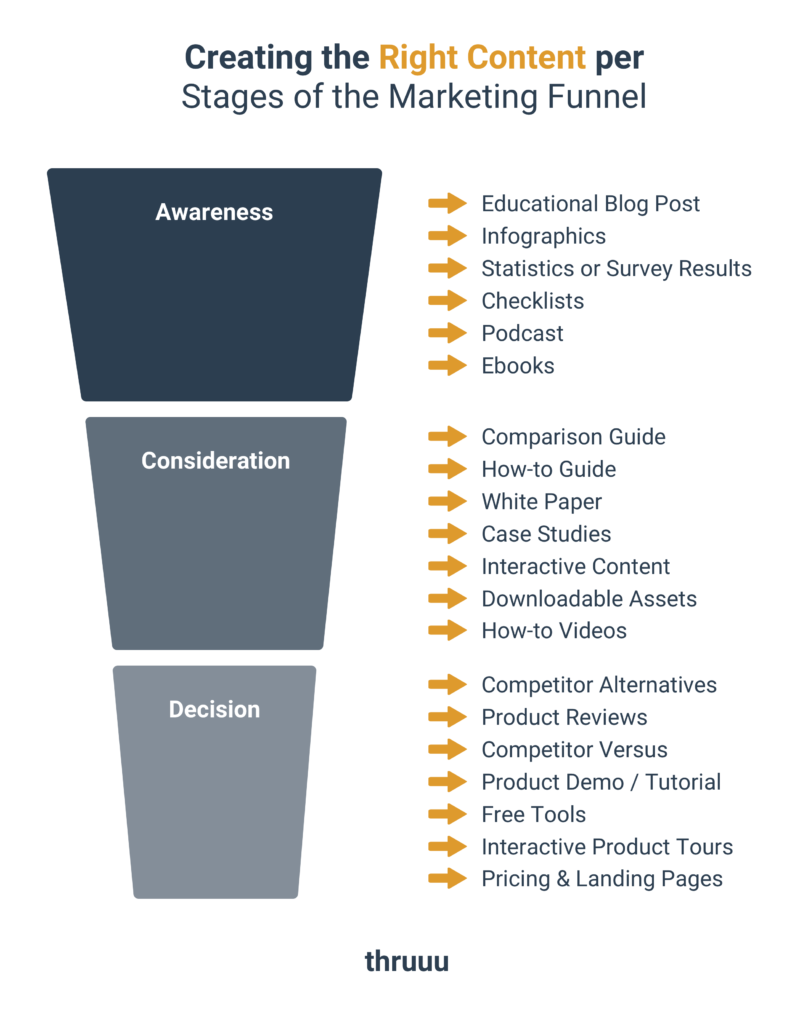
Stages of the Content Marketing Funnel
Awareness Stage
This is the initial stage of the marketing funnel, where the customer journey begins also known as Top of the Funnel (TOFU).
Your target audience becomes aware of a need or problem they have, and they begin seeking solutions.
At this stage, creating content that attracts customer’s attention is important because:
- It helps you to stand out in a competitive digital landscape.
- It helps to establish a positive first impression, increasing the likelihood of customers continuing through the funnel.
- It demonstrates your expertise and willingness to help, making customers more receptive to your brand.
- It can sow the seeds for future engagement. Even if prospects don’t convert immediately, they’re likely to remember your brand when they’re ready to make a decision.
Consideration Stage
At this stage, potential customers have moved beyond mere awareness and are actively evaluating their options.
This stage is also known as the Middle of the Funnel (MOFU).
Your goal here should be to create content that educates and demonstrates why your product or service is the best choice. You can do this by:
- Offering in-depth guides and whitepapers that delve into industry trends, challenges, and solutions.
- Providing objective product comparisons that highlight your unique benefits transparently.
- Showcasing real-life success with case studies and testimonials. Utilize visual content such as video tutorials.
- Engaging leads through email drip campaigns that gradually deliver relevant content, keeping your brand top-of-mind as they progress through the consideration stage.
Decision Stage
This stage marks the end of the content funnel, where prospects are now ready to make a purchase. It is also called the Bottom of the Funnel (BOFU).
To convert these prospects into loyal customers, you can create content that emphasizes your unique selling proposition, provides social proof, and persuasively convinces them to choose your product.
You can consider showcasing your product or service by doing the following:
- Utilizing limited-time offers or discounts to create a sense of urgency.
- Incorporating a clear and compelling call-to-action (CTA) to direct prospects.
- Offering side-by-side comparisons with competitors.
- Providing strong guarantees or warranties.
- Hosting live events like demonstrations or webinars.
- Addressing questions and offering support information.
Low Buying Intent vs. High Buying Intent: Understanding TOFU and BOFU
Understanding the concept of Top of the Funnel (TOFU) and Bottom of the Funnel (BOFU) is crucial for tailoring your strategies to the level of buying intent exhibited by prospects.
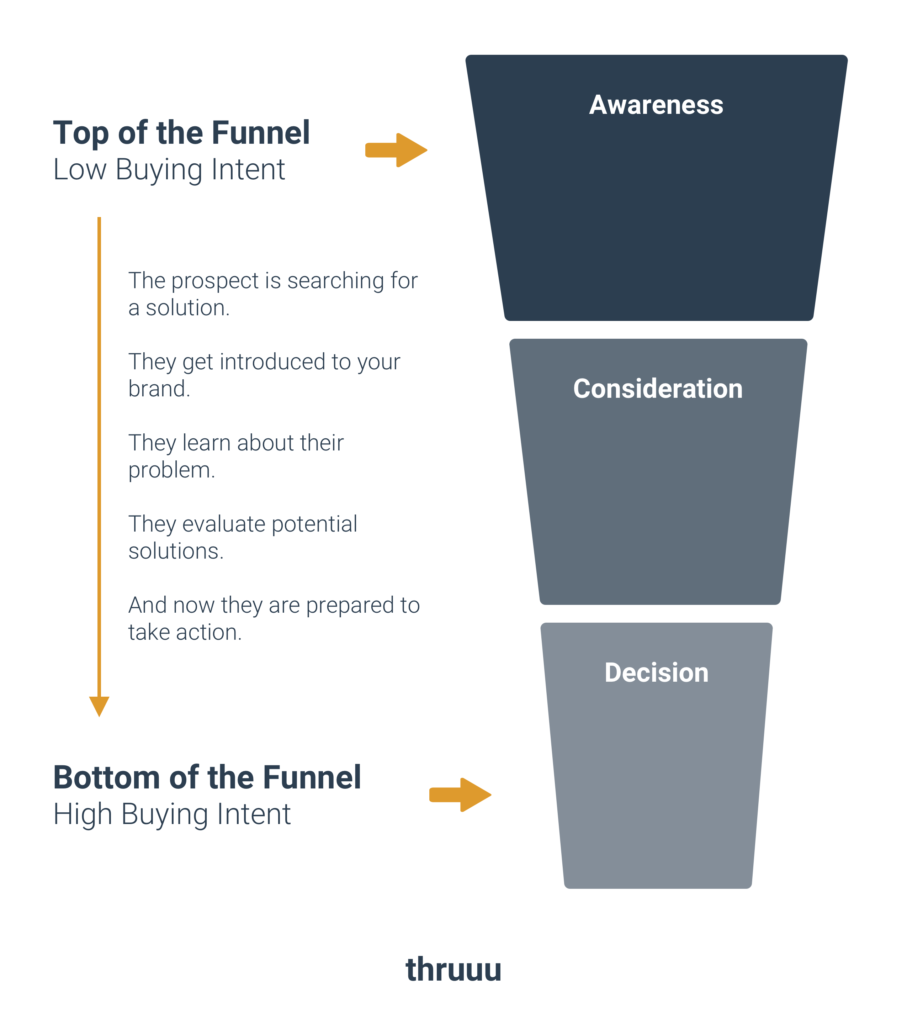
TOFU, representing the awareness stage, marks the entry point into the marketing funnel.
Here, prospects typically exhibit low buying intent.
They’ve just recognized a need or issue but aren’t actively seeking a solution yet.
Content in this stage should be educational and geared toward building awareness and interest. It introduces your brand and highlights its problem-solving value.
On the other hand, BOFU signifies the decision stage, the final stretch of the funnel.
Here, prospects have a high buying intent. They’ve progressed beyond awareness and consideration and are actively in search of a solution, nearing a decision.
Content in BOFU should focus on sealing the deal. It should emphasize your product or service’s unique advantages, offer social proof, and provide incentives for conversion.
Typically, prospects exhibit high buying intent when they reach the BOFU because they’ve gone through the earlier stages of the funnel, learned about their problem, evaluated solutions, and are now prepared to act.
Later, we’ll discuss what strategy to employ to prioritize conversion.
Creating the Right Content per Stage of the Buyer Journey
To create a successful content strategy, it’s important to understand the stages of the buyer’s journey.
These stages include “Awareness, Consideration, and Decision.”
At each stage, providing content that suits your audience’s mindset and requirements is essential.
Here, we will examine each stage closely and reveal the types of content that work best to connect, inform, and empower consumers on their path to making a purchase.
Content Ideas for the Awareness Stage (TOFU)
In the awareness stage of the buyer’s journey, the primary objective is to create content that grabs the attention of your target audience and introduces them to your brand.
This TOFU Content should be informative, engaging, and shareable.
We’ll look at a couple of examples for this stage.
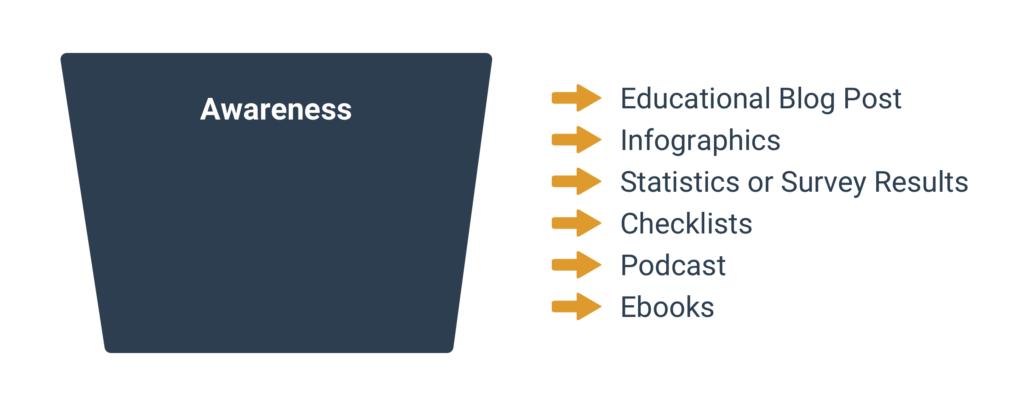
1. Educational Blog Post
An educational blog post is a written piece of content that addresses common questions and provides informative answers related to your product, service, or industry.
Tips
- Identify FAQs: Begin by identifying the frequently asked questions your potential customers have. These questions often represent their pain points or areas of interest.
- Thorough Research: Research and gather comprehensive information to answer these questions in-depth.
- Engaging Headlines: Craft attention-grabbing headlines that increase curiosity and indicate the topic of the post.
- Use Visuals: Use images, infographics, or videos to enhance understanding and engagement.
- Clear Structure: Organize your blog post with clear headings, subheadings, and bullet points for easy readability.
- SEO Optimization: Optimize your post for search engines by including relevant keywords without keyword stuffing.
- Internal Links: Include links to other relevant content on your website to encourage further exploration.
- Call to Action (CTA): Conclude the post with a CTA that invites readers to learn more, subscribe, or engage with your brand.
For example, an educational blog post for a fitness brand can address the question “How to Create an Effective Home Workout Routine.”
It should provide step-by-step guidance, exercise recommendations, and tips for staying motivated, catering to individuals in the awareness stage looking to start their fitness journey.
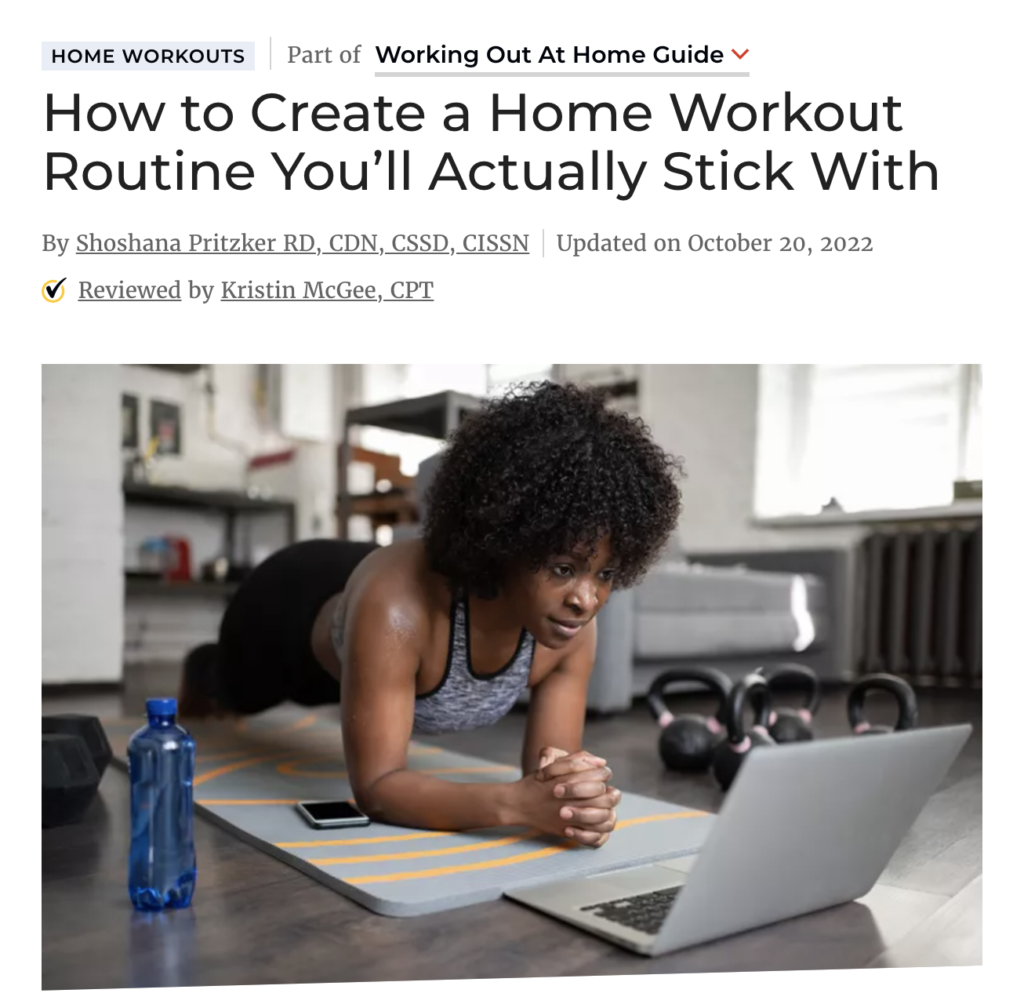
Shelley Morris, an SEO and Digital Marketing expert, recommends creating an ‘FAQ page‘ with common SERP questions scraped from thruuu. This can also help in obtaining a featured snippet. She is sharing an example with frequent questions about Pythons.
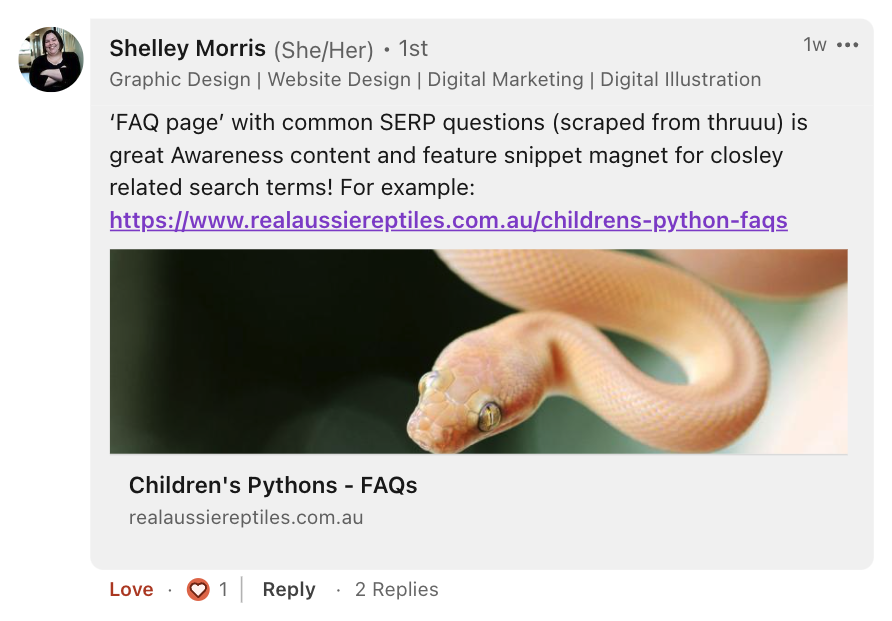
🚀 Pro Tip: Check this article explaining how to create a FAQ Blog Post. A great content format organized around questions and answers. The perfect TOFU content!!!
2. Infographics
Infographics are visual representations of information, data, or concepts. They condense complex information into a visually appealing and easy-to-understand format.
Tips
- Visual Appeal: Design visually striking infographics with a clear layout, colors, and icons that complement your content.
- Concise Information: Keep the information concise and focused. Infographics should convey key points quickly.
- Data Sources: Cite sources for any statistics or data presented in the infographic to establish credibility.
- Shareability: Make your infographics shareable on social media by providing easy sharing options.
- Mobile-Friendly: Ensure your infographics are responsive and viewable on various devices.
- Embed Codes: Include embed codes to encourage other websites to share your infographic, creating backlinks.
For example, an infographic for a nutrition website could visually show “The Benefits of a Mediterranean Diet,” delivering key health advantages and food components in an easy-to-understand format.
3. Statistics or Survey Results
Incorporating statistics or survey results into your content means using data to back up your statements, offer valuable insights, or shed light on prevailing trends within your industry.
Tips
- Data Accuracy: Ensure the statistics or survey data you use are accurate and from reputable sources.
- Visual Representation: Show data through charts, graphs, or tables to make it more accessible.
- Interpretation: Offer context and interpretation of the data to explain its significance.
- Linkable Assets: Survey results can serve as a linkable asset, attracting backlinks from websites looking for data-backed sources.
For example, a marketing agency might create a blog post titled “2023 Digital Marketing Trends: Insights from our Industry Survey,” presenting survey results about emerging trends with an emphasis on data-backed predictions.
We advise you to visit the blog of Exploding Topics as it shares great articles, including statistics and industry surveys.
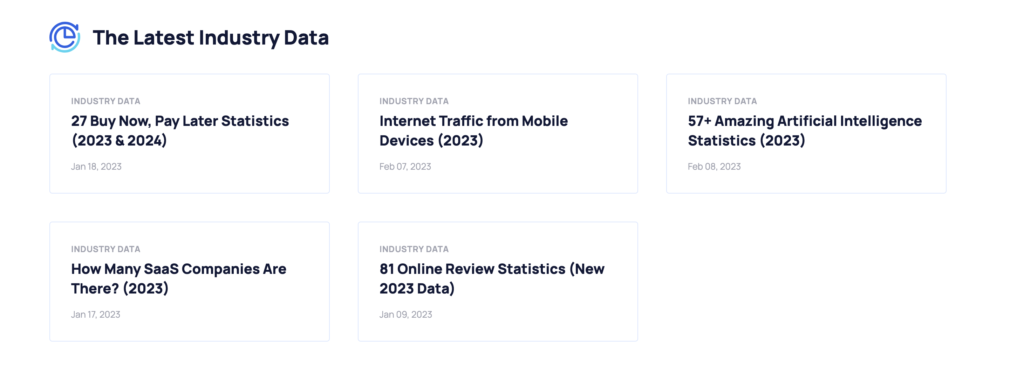
4. Checklists
Checklists are simple, actionable lists that guide users through a process or provide a step-by-step overview of a task or topic.
Tips
- Clear Steps: Ensure each item on the checklist is clear and actionable.
- Relevance: Write checklists to address common pain points or tasks your audience encounters.
- Visual Formatting: Use bullets or checkboxes for easy readability and interaction.
- Downloadable: Offer the checklist as a downloadable PDF to capture email leads.
For example, a cybersecurity firm could create a “Website Security Checklist” to help website owners ensure their sites are protected from common threats.
Users could download it in exchange for subscribing to their newsletter.
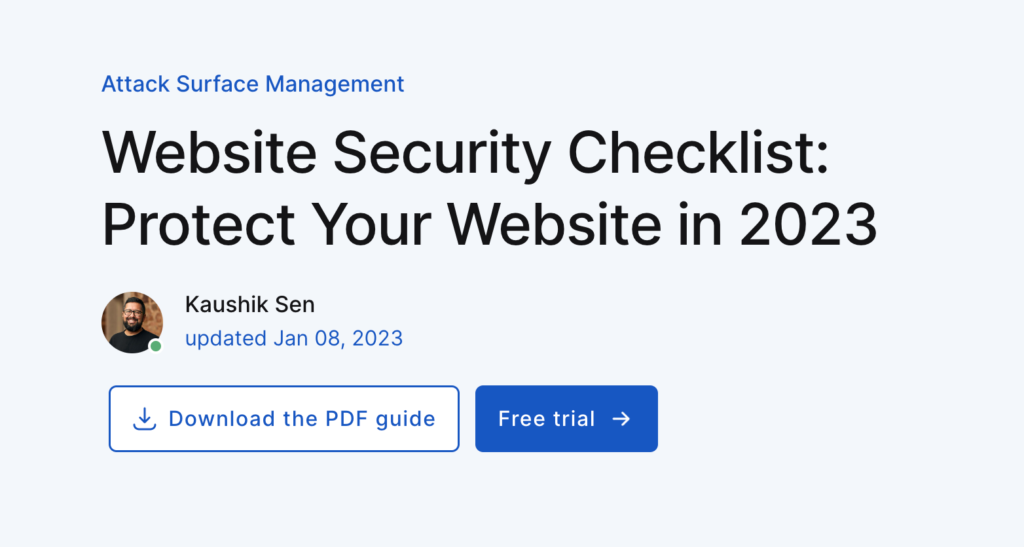
5. Podcasts
Podcasts are audio recordings where you can discuss topics, share insights, or interview experts in your industry.
Tips
- Engaging Content: Create podcast episodes that are engaging, informative, and relevant to your target audience.
- Regular Schedule: Maintain a consistent release schedule to keep your audience engaged.
- Promotion: Share your podcast on various platforms and social media to expand your reach.
- Invite Guests: Hosting industry experts or guests can bring fresh perspectives and attract a broader audience.
For example, a technology company might produce a podcast series discussing the latest tech trends, featuring interviews with prominent figures in the tech industry.
6. Ebooks
Ebooks are comprehensive digital documents that go deeply into specific topics, providing in-depth insights, research, and valuable information.
Ebooks usually require significant time and effort to create, including research, writing, and design.
Tips
- Topic Selection: Choose a topic that is relevant to your target audience and aligns with your industry or niche. Ensure it addresses a specific pain point or offers valuable insights.
- Thorough Research: Conduct thorough research to gather comprehensive information and data related to your chosen topic. Cite sources to establish credibility.
- Clear Structure: Organize your Ebook with a clear and logical structure. Use chapters or sections with descriptive titles to guide readers through the content.
- Engaging Title and Cover: Create an attention-grabbing title and visually appealing cover design. The cover is the first thing potential readers see, so make it enticing.
Ebooks have the added benefit of generating leads. You can offer free ebooks in exchange for an email address on your website. Then you can nurture these leads further.
For example, a financial advisory firm might offer an ebook titled “The Ultimate Guide to Retirement Planning,” covering various aspects of financial planning for retirement in-depth, which users can download in exchange for subscribing to their newsletter.
Content Ideas for the Consideration Stage (MOFU)
In this stage, potential customers are actively evaluating their options. To guide them toward choosing your product or service, your content should demonstrate its value and advantages, positioning it as a viable solution.
MOFU Content should focus on the job to be done, address specific points, and be useful.
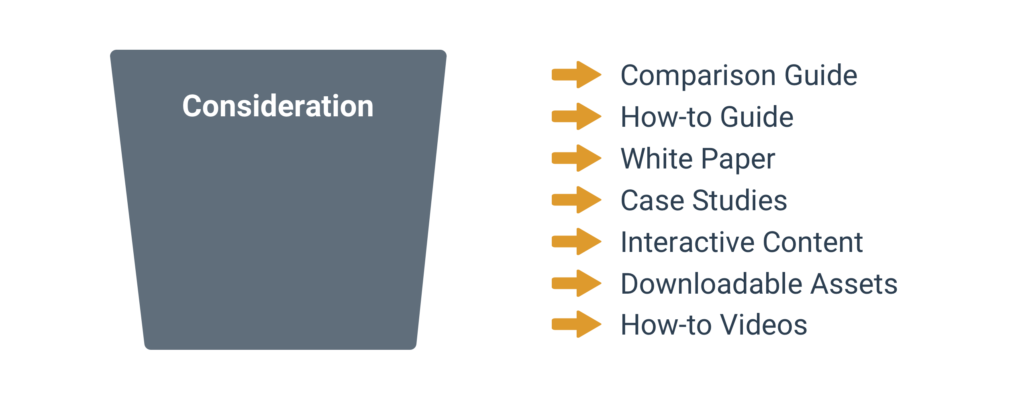
1. Comparison Guide
A comparison guide is a content piece that provides detailed comparisons of various solutions, products, or services, including yours. It helps prospects make informed decisions by highlighting the pros and cons of each option.
Tips
- Objectivity: Be objective in your comparisons, providing an unbiased view of the options.
- Highlight USPs: Emphasize your product or service’s unique selling points (USPs) while acknowledging areas where competitors excel.
- Visual Aids: Use tables, charts, or graphs to make comparisons visually accessible.
- Customer Reviews: Include customer testimonials or reviews to add authenticity.
For example, a software company could create a “CRM Software Comparison Guide” comparing the features, pricing, and user satisfaction scores of different CRM solutions, including their own.
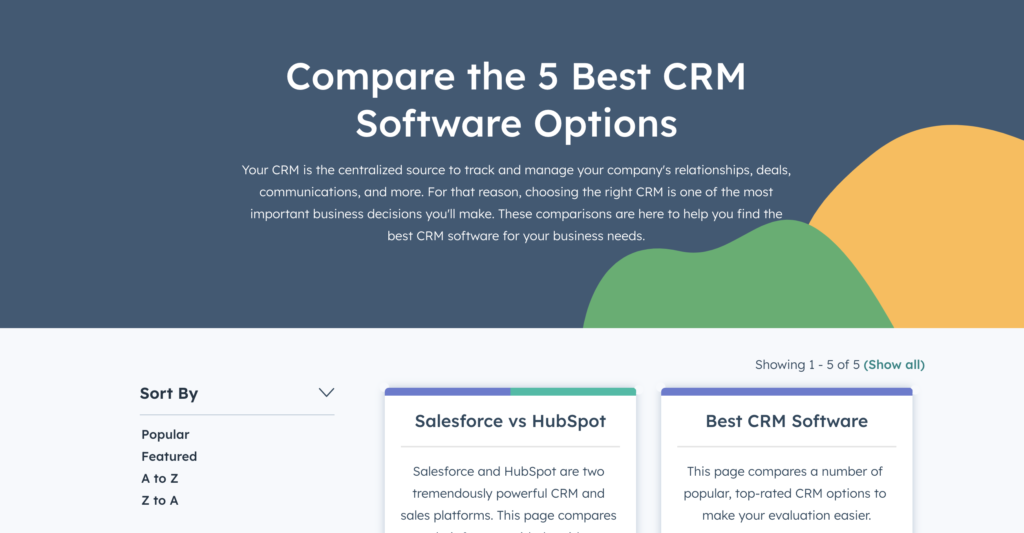
💡Discover: We have curated must-have SEO blog post templates designed to accelerate your content creation process.
2. How-to Guide
A how-to guide is a step-by-step content piece that addresses common pain points or challenges in your industry. It provides detailed instructions on solving these issues.
Tips
- Clear Steps: Break down the process into clear, easy-to-follow steps.
- Visuals: Use images, screenshots, or videos to illustrate each step.
- Real-World Examples: Include real-life scenarios or case studies to make the guide relatable.
- Practical Solutions: Focus on practical solutions that showcase your product or service as an effective tool.
For example, a marketing agency might create a “Social Media Advertising Strategy Guide,” offering step-by-step instructions on planning and executing effective social media ad campaigns while emphasizing how their services can simplify the process.
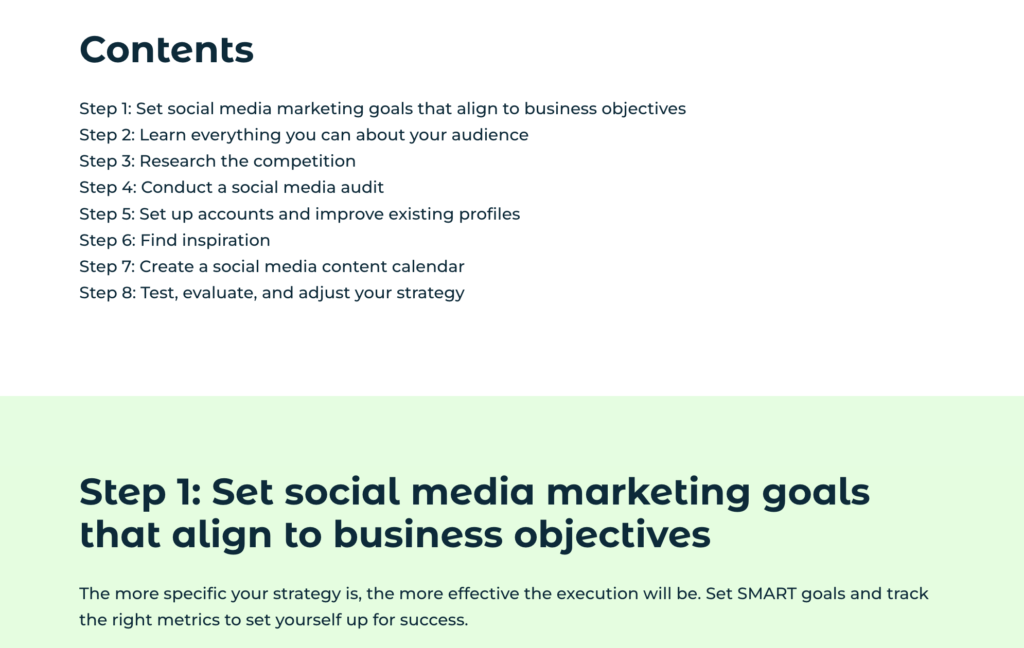
3. White Paper
A white paper is a comprehensive, in-depth report or document that explores a specific industry issue, technology, or solution.
It provides extensive research, analysis, and insights.
White papers can be used as gated content, requiring users to provide their email addresses to access, thus building your email list.
A downside to white papers is that they typically require substantial time and resources to research and produce.
Tips
- Choose a Relevant Topic: Select a topic that addresses a pressing issue or a trend in your industry. Ensure it aligns with your target audience’s interests.
- Thorough Research: Invest time in thorough research to gather credible data, statistics, and information related to your chosen topic. Use reputable sources to establish trust.
- Clear Structure: Organize your White Paper with a clear structure, including an introduction, sections, subheadings, and a conclusion. Use a table of contents for easy navigation.
- Engaging Introduction: Craft an engaging introduction that highlights the importance of the topic and what readers can expect to gain from the white paper.
4. Case Studies
Case studies are detailed accounts of a specific client, project, or use case where your product or service successfully addressed challenges and delivered results.
Tips
- Real-World Impact: Emphasize the real-world impact and tangible benefits your solution provided.
- Visuals: Use charts, graphs, or before-and-after visuals to illustrate the transformation.
- Client Testimonials: Include quotes or interviews with the client to add authenticity.
5. Interactive Content
Interactive content includes quizzes, calculators, or tools that engage potential customers. They encourage user participation and interaction.
For instance, using a GIF maker can add a fun, visual element to your interactive content, making it even more engaging.
Tips
- Relevance: Ensure the interactive content is directly related to your industry or product.
- Data Capture: Use interactive content as a means to collect user data or preferences.
- Shareability: Make it easy for users to share their results on social media, increasing the content’s reach.
Banks and insurance companies often employ this kind of content to offer loan calculators or insurance coverage calculators.
This tool could also help in lead capture, as the final step is often to enter your email address to obtain more information.
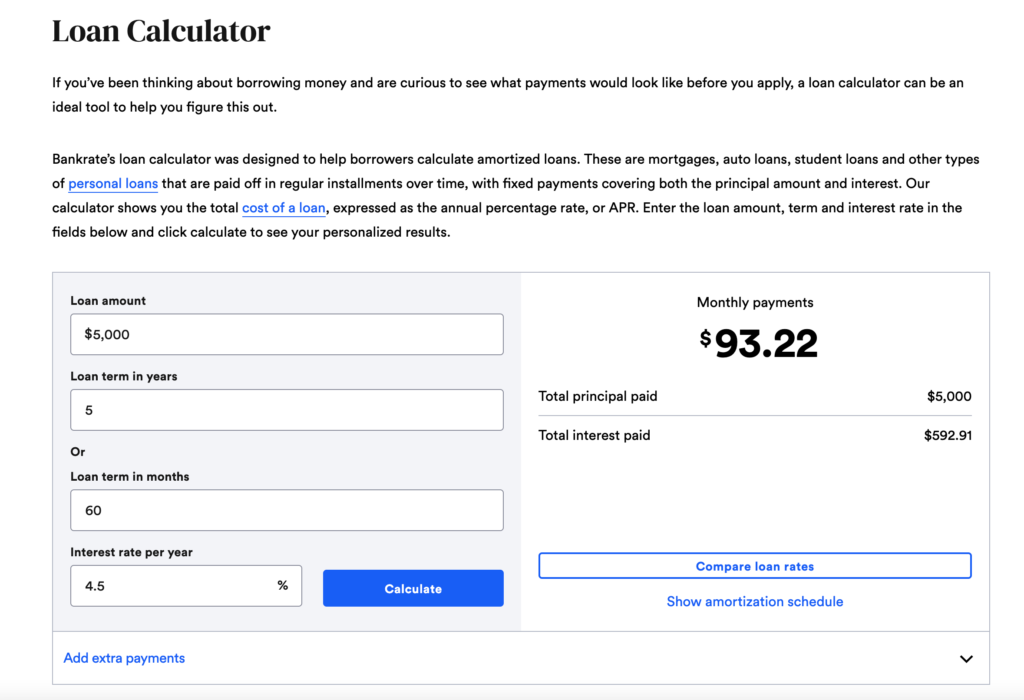
6. Downloadable Assets: Templates
Downloadable asset templates are ready-made documents or files that users can download and use.
These could be templates for detailed processes, workflows, or other useful resources.
Tips
- Customizability: Ensure the templates are easily customizable for user-specific needs.
- Clear Usage Instructions: Provide clear instructions on how to use the templates effectively.
- Value Demonstration: Highlight how these templates can simplify tasks or processes for users.
At thruuu, we take this approach and provide our audience with a library of content brief templates that can be downloaded in various formats.
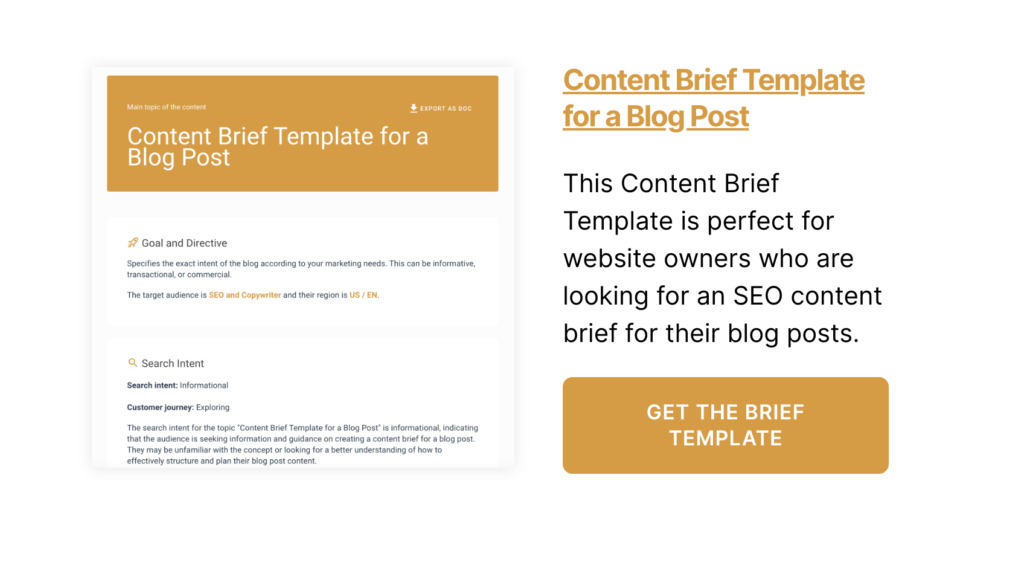
7. Webinars
Webinars are live or pre-recorded online seminars or presentations that allow you to engage with your audience in real-time.
They can be used to showcase your expertise, demonstrate your product, or address industry topics.
Tips
- Interactive Q&A: Include a Q&A session to interact directly with attendees.
- Relevance: Ensure the webinar content is highly relevant to your audience’s needs.
- Promotion: Promote your webinar in advance to maximize attendance.
8. How-to Videos
How-to Videos are video content pieces that demonstrate how your product or service solves specific issues or fulfills particular needs. They provide practical solutions and instructions.
Tips
- Clear Demonstration: Ensure your videos provide a clear, step-by-step demonstration of how to use your product to solve common problems.
- Conciseness: Keep videos concise and focused on addressing specific pain points.
- Quality Production: Invest in good video and audio quality for a professional look.
Below, you can watch an “How-To” video explaining how to create topic clusters with the thruuu keyword clustering and topic cluster tool.
Content Ideas for the Decision Stage (BOFU)
In this stage, potential customers are close to making a choice.
BOFU Content should provide reassurance, remove doubts, and give compelling calls-to-action (CTAs).
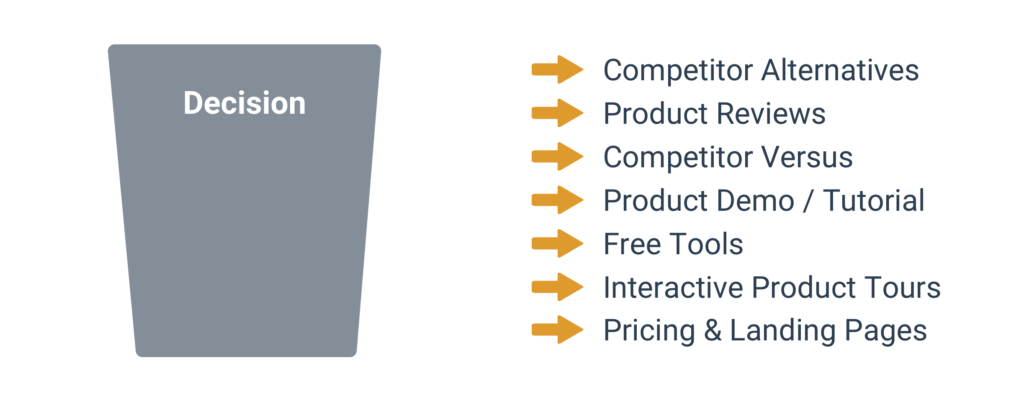
1. Competitor Alternatives
Competitor alternative content highlights the differences between your product or service and those of rivals. It often includes clear pricing comparisons and showcases why your offering is superior.
Tips
- Transparency: Be transparent and unbiased in your comparisons.
- Focus on USPs: Emphasize your unique selling points that set you apart.
- Customer Testimonials: Include testimonials from customers who switched to your product from a competitor.
2. Product Reviews
Product review content provides lists or rankings of the best products or services in a particular category or industry. It can help potential customers make a well-informed decision.
Tips
- In-Depth Analysis: Provide detailed insights into the features, benefits, and drawbacks of each product.
- Updated Information: Ensure your reviews are current and show the latest offers in the market.
- User Reviews: Include user reviews and ratings to add credibility to your recommendations.
As an example, at thruuu, we follow this content format and offer a review of the best SERP Scrapers and Analyzers.
The goal is to attract people looking for a SERP Analysis tool while also emphasizing thruuu’s value proposition in comparison to its main competitors.
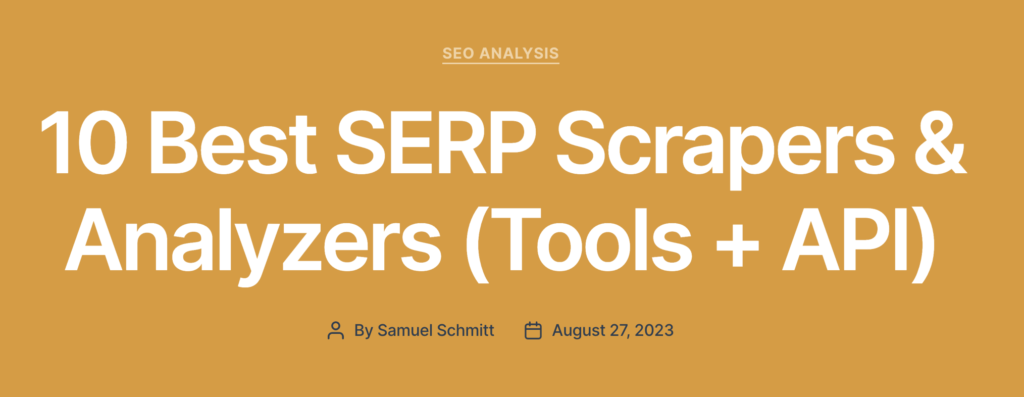
3. Competitor Versus
The competitor versus content compares your product directly with a single competitor. It highlights the strengths and weaknesses of each, helping potential customers make informed decisions.
Tips
- Objective Analysis: Provide an objective and unbiased analysis of both products.
- Focus on Key Metrics: Highlight key metrics, such as pricing, features, and customer support.
- Visual Comparisons: Use tables or visuals to present comparisons.
The blog format is straightforward and is often titled “Product A vs. Product B.” You can even compare your product versus two competitors as Ahref did in its comparison with SEMRush and MOZ.

4. Product Demo / Tutorial
Product Demo or Tutorial content showcases your product through either a written blog post or a video. It provides an in-depth look at how your product works and its benefits.
Tips
- Thoroughness: Ensure the demo or tutorial covers all major features and functions.
- Use Cases: Demonstrate how your product can solve real-world problems.
- Address FAQs: Anticipate common user questions and address them in the content.
Below is a video showcasing a tutorial about how to use the thruuu content brief tool.
5. Free Tools
Free tools are an excellent format for the decision phase. They can help your audience experiment with your product or a specific feature of your product for free. This strategy works very well for SaaS.
Tips
- Explain Utility: Describe how the free tool can benefit users in their specific tasks or workflows.
- Showcase Ease of Use: Highlight how user-friendly the tool is and how it integrates with existing processes.
- Highlight Benefits of Paid Version for SaaS: If applicable, your free tool could invite users to try your paid tool for additional benefits.
At thruuu, we created a set of free SEO content writing tools. Each individual tool is an extract of what the paid version of thruuu can offer.
The goal is to attract people by offering a lot of value for free while showcasing the value of the paid version. This strategy helps us acquire new users every month.

6. Interactive Product Tours
Interactive product tours involve guided tours or walkthroughs that showcase the features and benefits of your product. This format is particularly effective for SaaS products.
Tips
- User-Friendly Interface: Ensure the tour is easy to navigate and interact with.
- Highlight Key Features: Focus on the most valuable features and benefits.
- Engage and Educate: Use interactive elements to engage users and educate them about your product’s value.
To implement such a feature on your website you can use Product Tour Software such as UserPilot or Intercom.
7. Customer Testimonials
Customer testimonial content shares feedback and reviews from satisfied customers. It adds social proof and builds trust.
Tips
- Diversity: Include testimonials from different types of customers (e.g., industry, company size) to appeal to a broad audience.
- Include Results: Highlight specific outcomes or results achieved by customers using your product.
- Use Real Names and Photos: Whenever possible, use real names and photos to make the testimonials more authentic.
At thruuu, we are really proud to share on our home page testimonials of long-time users such as Tom Shapiro, CEO of the excellent Boston-based Marketing Agency.
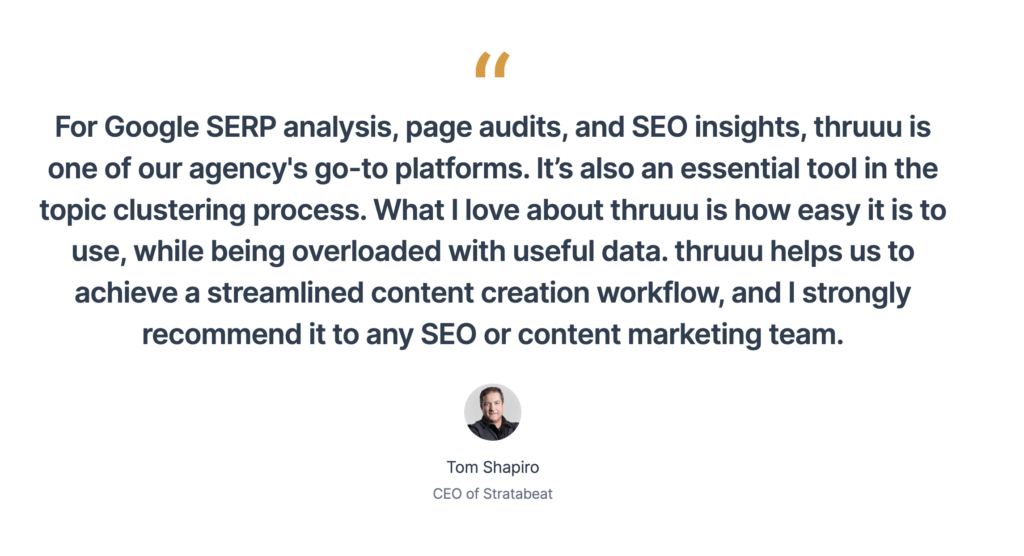
8. Pricing Explanation
Pricing explanation content provides detailed information about your pricing model, helping potential customers understand the cost structure of your product or service.
Tips
- Transparency: Be transparent about your pricing, including any tiers, plans, or add-ons.
- Value Proposition: Explain what customers get for each pricing tier, highlighting the value they receive.
- Visual Aids: Use pricing tables or charts to make the information more visually accessible.
- FAQs: Include answers to common pricing-related questions.
9. Delivery Model Explanation
Delivery model explanation content is relevant for agencies and service providers. It explains how you work with clients and outlines the next steps if they contact you.
Tips
- Process Overview: Provide a step-by-step overview of how you engage with clients, from initial contact to project completion.
- Communication Channels: Explain the primary communication channels you use to collaborate with clients.
- Expectations: Set clear expectations for what clients can expect during the engagement.
- CTA: Include a clear call to action for potential clients to take the next step in contacting you.
10. ROI Calculators
ROI calculators are tools that estimate the return on investment (ROI) of your product or service. They help potential customers understand the value they can gain.
Tips
- Customization: Allow users to input their specific data to personalize the ROI estimate.
- Clear Explanation: Provide explanations of how the calculator works and what inputs are needed.
- Visual Results: Present the ROI estimate in a visual format, such as graphs or charts.
- Educational Content: Accompany the calculator with content that explains the significance of ROI and how your product contributes to it.
Hubspot is an excellent example. Based on aggregated data from 177,000+ HubSpot customers worldwide, you can calculate your potential return on investment with HubSpot products.

11. Landing Page
Landing Pages are often short-form web pages that focus on a specific feature of your SaaS or service. They are designed to capture user attention and encourage action.
Tips
- Focused Messaging: Keep the content on the landing page concise and focused on the feature or value proposition.
- Clear CTA: Include a clear and compelling call to action, such as signing up for a free trial or requesting more information.
- Visuals: Use visuals, such as images or videos, to illustrate the feature or service.
- A/B Testing: Consider A/B testing different versions of your landing page to optimize conversions.
Content Strategy: Prioritizing BOFU and High-Intent Content?
Regarding content strategy, experts in the field of SEO and marketing have shared valuable insights on what works best.
For example, Jake Ward has been a proponent of “flipping the funnel.”
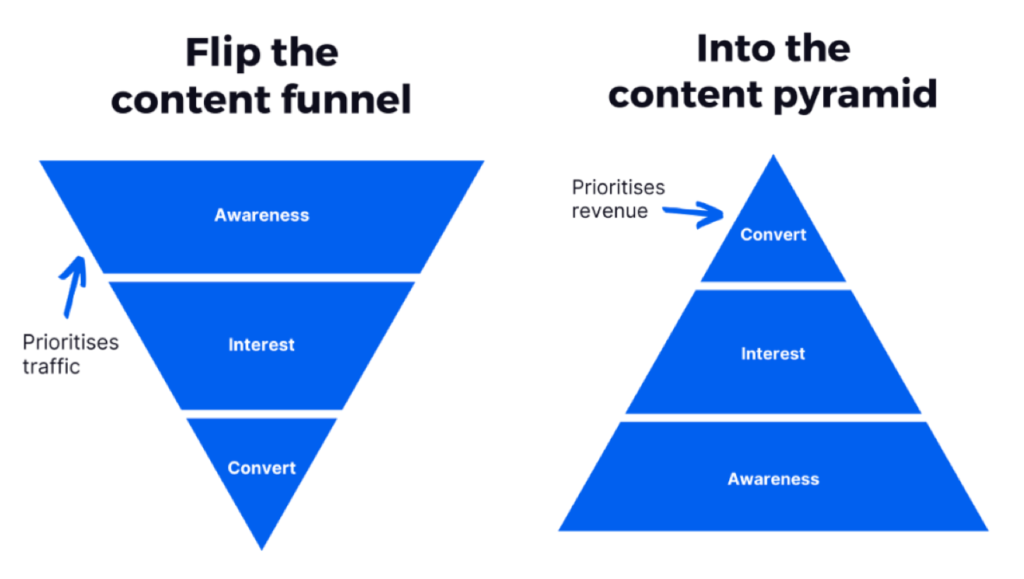
This approach suggests focusing on BOFU content, which targets users with high buying intent.
BOFU keywords and content are strategically crafted to capture the attention of prospects who are close to making a purchase decision.
The advantage here is that BOFU content often has a better conversion rate, directly addressing the needs of those ready to take action.
Even notable figures like Brian Dean, known for his experience in SEO, initially emphasized TOFU content.
However, Brian and his startup are now making a significant shift towards BOFU content as explained in the video below.
Growth and Convert Agency, another digital marketing player, strongly emphasizes BOFU keywords and content.
Their strategy aligns with the principle that reaching prospects in the Decision stage is an effective way to boost conversion rates as described in their blog post.
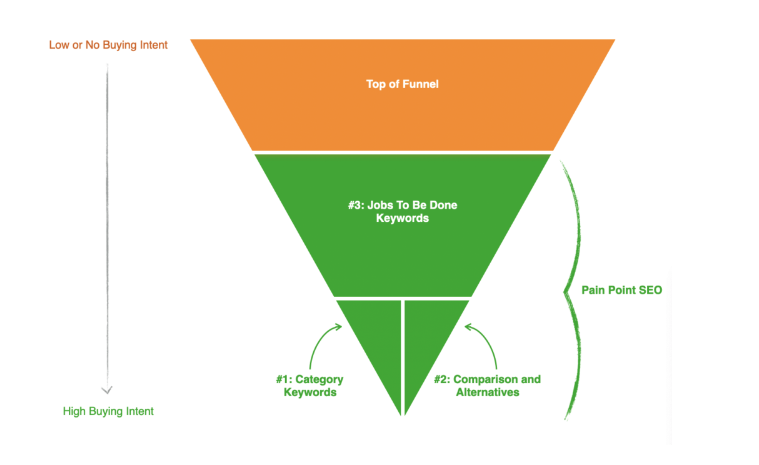
The consensus among experts is clear: prioritizing BOFU and High-Intent content is a strategic move in the world of SEO and marketing.
By addressing the needs of prospects who are ready to convert, you can maximize your chances of turning them into valuable customers.
However, we might challenge this approach because, in the long run, you will need to be visible at all stages of the customer journey and create BOFU and TOFU content.
As Benjamin André, an SEO Consultant, has pointed out, sales cycles are getting longer. It is essential to cover every stage of the customer journey with the right content.
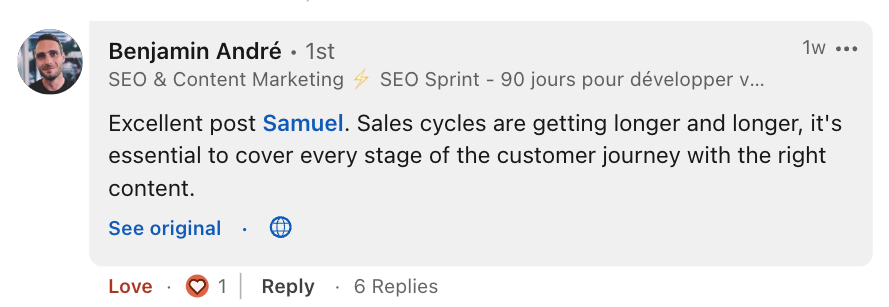
Remember that the best long-term strategy is to build a brand and be visible at every customer touchpoint.
Empower Your Content Team
Our end-to-end content optimization solution empowers your team to crack the Google algorithm, craft exceptional content, and achieve remarkable organic search results.
